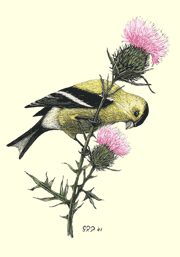 |
Earth Journal by Gary Pendleton |
August’s Goldfinches
What’s sad about these golden surprises?
The back door swings open, and I step outside to get a tool from the garage. Or maybe I was going to pick a cucumber or catch some air. But I am distracted and for a moment I forget what I wanted to do. The cause of my distraction is a flock of goldfinches that swoops up and away in a flurry of bright yellow and black. The visual display is accompanied by a chorus of high, sweet sounds. The goldfinches have come back. They weren’t here the day before, and who knows if they will stay until tomorrow.
Some of the flock had been feeding on the seeds of purple coneflower and sunflower; others had been helping themselves to the tiny black seeds dispensed from the finch feeder. Too quick to count, the birds may have numbered over a dozen.
The bird feeder I refer to is sometimes called a thistle feeder, but the name is misleading. Goldfinches are known to have a fondness for the seeds produced by this familiar weed, but the thistle seeds you buy at the store are really from a flower that grows in Africa, and the seeds are properly known as Niger. Lisa Garrett, owner of the Wild Bird Center in Bowie, told me that these seeds have been treated to keep them from sprouting and becoming noxious weeds in this country. When not using one of the feeders she sells, goldfinches easily hang upside down to glean the seeds from flower heads.
Goldfinches are one of the most popular and familiar birds in North America. The citizens of New Jersey even voted it their state bird. It is no wonder they are so popular, given their bright colors and lively behavior. How could a flock of goldfinches inspire any emotion other than cheerful ones?
The great naturalist Carols Linnaeus seemed to have a different impression. Carduelis tristis is the scientific name that Linnaeus gave to the species. Tristis, we are told, means sad.
No one knows what inspired this seemingly odd choice for a name, though some speculate that it is because of the plaintive notes that goldfinches sometimes sing. Linnaeus himself surely never heard the song of the goldfinch; the only ones that he ever saw were lifeless stuffed specimens shipped from overseas. I suspect that if Linnaeus had ever seen a flock of live finches bursting forth from a field of wildflowers, he would have come up with another name.